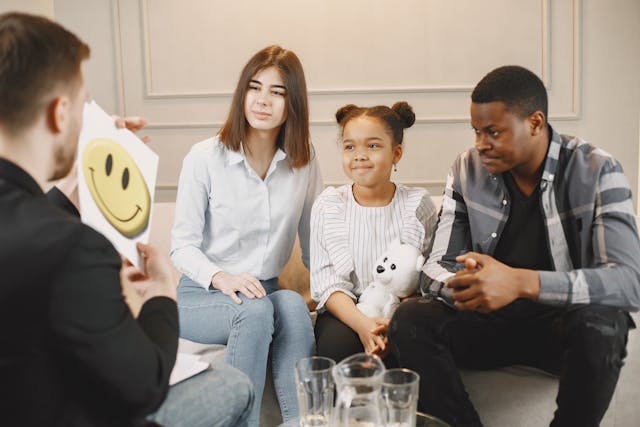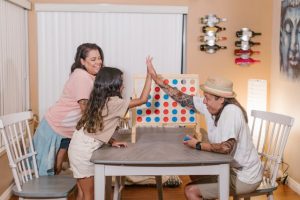How to Improve Communication with Family Therapy Activities: Practical Tips for Stronger Bonds

- Effective communication fosters understanding, empathy, and cohesion within families.
- Common challenges include misunderstandings, conflicts, and lack of active listening, eroding trust and connection.
- Family therapy activities offer structured approaches to address communication challenges, fostering empathy and constructive dialogue.
- Implementing active listening and constructively expressing feelings helps cultivate open and respectful communication in daily life.
- By prioritizing communication skills, families can bridge gaps, strengthen bonds, and nurture healthier relationships.
Effective communication is crucial for strong familial relationships, nurturing understanding, empathy, and cohesion. In the intricate web of family dynamics, clear and open communication acts as the vital conduit for expressing emotions, resolving conflicts, and fostering deeper connections. However, modern life’s complexities often challenge this fundamental aspect, leading to misunderstandings, tensions, and strained bonds. Recognizing this, many turn to family therapy activities as a means to fortify communication skills and address underlying issues.
Family therapy activities for communication provide a structured and supportive environment for families to navigate challenges, fostering empathy and promoting constructive dialogue. Through these activities, individuals learn to communicate more effectively, express their needs and concerns, and listen attentively to one another. By engaging in such activities, families can bridge gaps, cultivate mutual respect, and strengthen their bonds, ultimately paving the way for healthier and more fulfilling relationships.
Understanding the Importance of Communication in Families
Effective communication is the lifeblood of healthy family dynamics, serving as the bedrock upon which trust, connection, and intimacy flourish. Within the familial context, communication is more than mere exchanging of words; it encompasses expressing emotions, needs, and desires and plays a pivotal role in shaping identities and fostering a sense of belonging. Clear and open communication enables family members to understand each other’s perspectives, resolve conflicts amicably, and provide support during times of need. Moreover, it cultivates an environment of mutual respect and validation where individuals feel heard, valued, and understood.
Conversely, poor communication within families can wreak havoc on relationships and emotional well-being, leading to many issues ranging from misunderstandings to deep-seated resentments. When communication channels break down, individuals may feel isolated, unheard, and disconnected from their loved ones. Misinterpretations and unexpressed grievances can fester beneath the surface, eroding trust and intimacy over time.
Moreover, unresolved conflicts and pent-up emotions can give rise to stress, anxiety, and even depression, casting a shadow over the overall family dynamic. Thus, the impact of poor communication reverberates far beyond surface-level disagreements, permeating into the very fabric of familial relationships and emotional health.
Common Communication Challenges in Families
In the intricate landscape of familial relationships, communication is the cornerstone upon which trust, understanding, and connection are built. However, various challenges often arise amidst the complexities of family dynamics, hindering effective communication and jeopardizing the harmony within the family unit. Families face a few common communication challenges involving various nuances of misunderstandings, conflicts, and the absence of active listening. Understanding these challenges is crucial for fostering healthier communication patterns and nurturing stronger familial bonds.
Misunderstandings and Miscommunications
Misunderstandings within family relationships often stem from various sources, ranging from differences in communication styles and expectations to the influence of past experiences and unresolved conflicts. These disparities in communication approaches can lead to misinterpretations of intentions, emotions, and meanings, resulting in confusion and discord within the family unit. Moreover, miscommunications may arise due to assumptions or lack of clarity in expressing thoughts and feelings, further exacerbating tensions and straining relationships.
The effects of miscommunication within families extend far beyond surface-level disagreements, profoundly impacting trust and connection among members. When misunderstandings persist, trust may erode as individuals question the reliability and sincerity of communication within the family. Moreover, repeated instances of miscommunication can breed resentment and emotional distance, creating barriers to genuine understanding and intimacy.
Over time, unresolved misunderstandings may chip away at the foundation of familial bonds, weakening the sense of unity and cohesion vital for nurturing healthy relationships. Addressing misunderstandings and enhancing communication clarity are essential steps towards restoring trust and fostering deeper connections within the family.
Conflict Resolution
Conflicts are an inevitable part of family life, arising from a myriad of sources ranging from differing values and expectations to competition for resources and attention. Common sources of family conflicts include disputes over household chores, financial matters, parenting styles, and divergent life goals. Additionally, unresolved issues from the past, such as unresolved grievances or family trauma, can resurface and contribute to ongoing tensions. Individual differences in personalities, communication styles, and problem-solving approaches can also exacerbate conflicts, making resolution challenging.
Effective conflict resolution strategies are crucial for maintaining harmony within the family unit and fostering healthy relationships. Families can prevent escalation and minimize the negative impact on relationships and emotional well-being by addressing conflicts promptly and constructively. These strategies may involve active listening, empathetic communication, and the willingness to compromise and find mutually beneficial solutions. Furthermore, fostering an environment of respect, understanding, and validation can create a safe space for open dialogue and collaborative problem-solving. Ultimately, navigating conflicts skillfully strengthens familial bonds and cultivates resilience and adaptability within the family, laying the groundwork for long-term harmony and cohesion.
Lack of Active Listening
Active listening is one of the most important factors that lead to effective communication within families, and it is pivotal in fostering understanding, empathy, and connection among members. By active listening, individuals demonstrate genuine interest and respect for each other’s perspectives, fostering a sense of validation and trust within the family unit. Moreover, active listening facilitates a deeper understanding of emotions, needs, and concerns, paving the way for more meaningful and authentic interactions.
Practicing active listening within family interactions involves several key strategies to enhance communication and promote mutual understanding. First and foremost, it means giving full attention to the speaker, maintaining eye contact, and refraining from interrupting or formulating responses prematurely. Additionally, paraphrasing and summarizing the speaker’s message demonstrate comprehension and validate their experiences, fostering a sense of empathy and connection. Furthermore, asking open-ended questions and expressing genuine curiosity can encourage further exploration of thoughts and feelings, deepening the level of engagement and understanding within the conversation. Doing these can cultivate stronger bonds, resolve conflicts more effectively, and nurture healthier communication patterns within the household.
Family Therapy Activities to Improve Communication
Family Meetings
Family meetings offer a structured platform for open communication, enabling members to address concerns, share perspectives, and strengthen bonds. By fostering a collaborative environment, these meetings allow individuals to feel heard, valued and understood within the family dynamic. They also promote a sense of unity and cohesion by encouraging collective problem-solving and decision-making.
Conducting productive family meetings involves several key guidelines. First, establish a consistent schedule to ensure regularity and predictability. Secondly, create a safe and respectful space where all members feel comfortable expressing their thoughts and feelings without fear of judgment. Thirdly, an agenda should be set beforehand to keep discussions focused and productive, allowing each member to contribute meaningfully. Finally, actively listen to each other’s perspectives, validate experiences, and strive for consensus when making decisions. By adhering to these guidelines, family meetings can be practical tools for enhancing communication and strengthening familial bonds.
Communication Games and Exercises
Injecting fun and interactivity into communication practices can significantly enhance engagement and skill development among family members. Role-playing scenarios offer a dynamic way to practice effective communication by simulating real-life situations and encouraging empathy and understanding. Communication-building activities like sharing stories or discussing hypothetical scenarios promote active listening and perspective-taking, fostering connection and mutual respect. Trust exercises, such as blindfolded partner walks or trust falls, strengthen bonds and reinforce the importance of clear communication and reliance on one another.
These interactive games and exercises are valuable tools for improving communication skills within the family unit. Hands-on practice opportunities in a supportive environment help members develop confidence, empathy, and effective communication strategies. Engaging in these activities fosters a sense of camaraderie and teamwork, reinforcing the idea that effective communication is a collaborative endeavor that benefits the entire family.
Journaling and Reflection
Journaling is another powerful tool for self-reflection and expression within family therapy, offering individuals a private space to explore their thoughts, emotions, and experiences. Through journaling, family members can gain insights into their perspectives and behaviors, fostering greater self-awareness and personal growth. Journaling provides an outlet for processing complex emotions and navigating challenging situations, allowing individuals to articulate their feelings more clearly and develop coping strategies.
Therapists may provide prompts and exercises tailored to specific therapeutic goals to encourage family members to engage in journaling and reflection. These prompts may include questions about family dynamics, individual strengths and challenges, or personal and relational growth goals. Additionally, therapists may suggest journaling exercises such as gratitude journaling, where family members reflect on moments of appreciation and connection within the family, or emotion tracking, where individuals document their emotional experiences throughout the day. By incorporating journaling into family therapy sessions, therapists can facilitate deeper exploration and communication, ultimately fostering greater understanding and cohesion within the family unit.
Implementing Communication Strategies in Daily Life
Active Listening Techniques
Active listening is a fundamental communication skill that fosters understanding, empathy, and connection within the family. Practicing active listening involves various strategies to ensure each family member feels heard and valued.
One effective technique is paraphrasing, where listeners rephrase what they’ve heard in their own words to demonstrate understanding and clarify any potential misunderstandings. Similarly, summarizing involves condensing the speaker’s main points to provide a concise overview of the conversation, helping to reinforce key messages and maintain focus.
Another crucial aspect of active listening is validating and acknowledging each family member’s perspective. This involves expressing empathy and understanding towards their feelings and experiences, even if they differ from one’s own. By acknowledging the validity of each perspective, family members can cultivate an environment of mutual respect and acceptance where everyone feels valued and understood.
Additionally, nonverbal cues such as maintaining eye contact, nodding, and using affirming gestures can convey attentiveness and support, further enhancing the active listening experience. By incorporating these strategies into daily interactions, families can cultivate deeper connections, resolve conflicts more effectively, and foster a culture of open and respectful communication.
Effective Expression of Feelings
Encouraging open and honest communication about emotions within the family is vital for fostering understanding, empathy, and connection among its members. Creating a safe and supportive environment where individuals feel comfortable expressing their feelings without fear of judgment or reprisal is crucial. This involves actively listening to each other’s emotions without dismissing or invalidating them, thus creating space for genuine emotional expression.
Techniques for expressing feelings constructively and respectfully include using “I” statements to convey emotions without placing blame or making accusations. For example, instead of saying, “You always make me feel ignored,” one might say, “I feel ignored when I don’t get a response to my messages.” This approach shifts the focus from the other person’s actions to one’s own feelings, fostering a more constructive dialogue.
Practicing mindfulness can also help individuals tune into their emotions and communicate them more effectively. By pausing to identify and acknowledge their feelings before expressing them, family members can avoid reacting impulsively and respond thoughtfully and respectfully instead. Moreover, setting aside time for regular check-ins or family meetings to discuss emotions can provide structured opportunities for sharing feelings and addressing concerns in a supportive setting. By embracing these techniques, families can cultivate a culture of emotional openness and authenticity, leading to deeper connections and healthier relationships.
FAQs (Frequently Asked Questions)
How can I encourage reluctant family members to participate in communication activities?
Encourage reluctant family members by creating a safe space, validating their perspectives, and using non-confrontational language. Offer activities they enjoy and emphasize the benefits of improved communication for stronger family bonds.
Are there communication activities suitable for families with young children?
Communication activities for families with young children can include storytelling, drawing feelings, and role-playing. These activities are interactive and help develop communication skills in a fun and engaging way.
What should I do if family therapy activities exacerbate tensions rather than alleviate them?
If tensions arise, pause and validate feelings. Adjust activities to focus on building understanding and trust. Consider seeking guidance from a therapist for personalized strategies.
How long does it typically take to see improvement in family communication through therapy activities?
Improvement varies, but consistent practice can yield noticeable results within a few weeks to months. Patience, openness, and commitment are key to seeing long-term benefits.
Can family therapy activities be effective if one family member is resistant to participation?
Family therapy activities can still be effective if one member is resistant. Tailor activities to suit their comfort level, validate their concerns, and gradually encourage participation to foster a supportive environment for all.
People Also Ask
How do I maintain consistency in practicing therapy activities within my family’s busy schedule?
Set a regular schedule, prioritize activities, and involve family members in planning. Keep sessions short and flexible, adapting to fit into daily routines.
Are there specific therapy activities recommended for addressing generational communication gaps within families?
Activities like storytelling, family history sharing, and role-playing generational scenarios can bridge communication gaps by fostering understanding and empathy.
Can online resources or apps supplement in-person therapy activities to improve family communication?
Online resources about communication games, virtual family meetings, and therapy apps offer convenient ways to enhance communication skills. Apps like “Talkspace” for virtual therapy sessions and “OurFamilyWizard” for co-parenting communication can also help.
- Conclusion
Enhancing family communication through therapy activities offers numerous benefits, including fostering understanding, empathy, and cohesion within the family unit. Families can navigate conflicts more effectively by addressing common challenges, implementing practical strategies, and nurturing healthier relationships. Families must prioritize communication and invest in strengthening their bonds, as open and respectful communication forms the foundation of strong familial connections. However, if communication challenges persist, seeking professional guidance from a therapist or counselor can provide valuable support and guidance. Remember, the journey towards improved communication is ongoing, but the rewards of stronger family bonds are well worth the effort.




